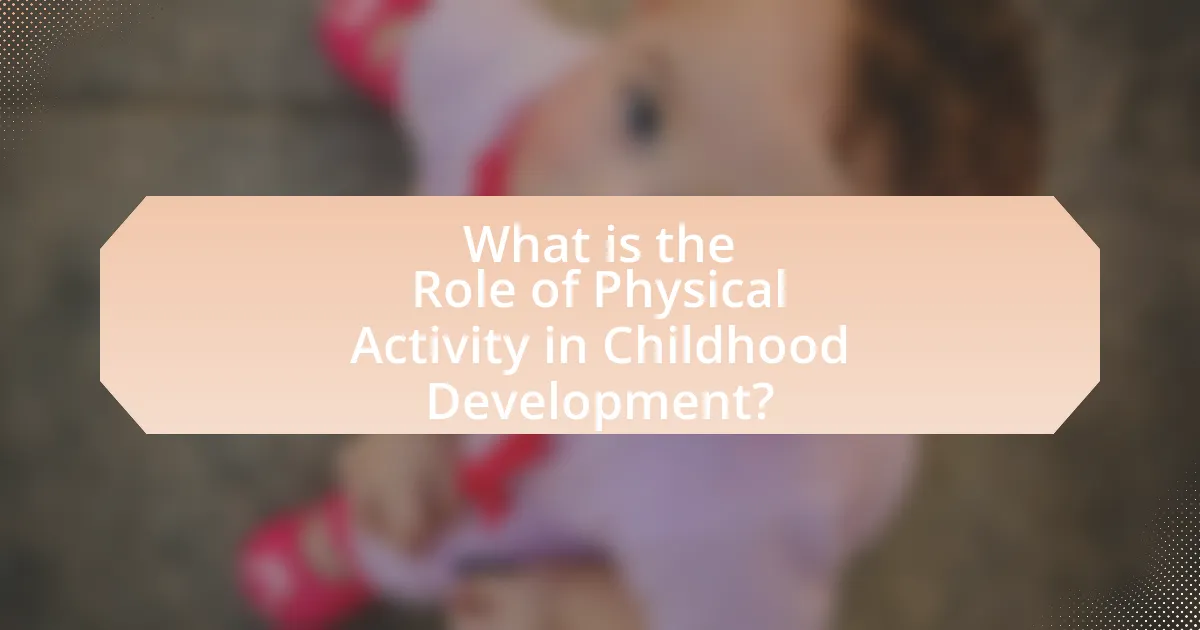The article examines the critical role of physical activity in childhood development, emphasizing its impact on physical health, cognitive function, and social skills. It highlights how regular physical activity promotes healthy growth, enhances cognitive abilities, and fosters emotional well-being, while also addressing the barriers to participation and the importance of structured play. Key findings include the correlation between physical activity and improved academic performance, social competence, and overall health outcomes. The article also outlines guidelines for physical activity in children and offers strategies for parents and educators to encourage active lifestyles.

What is the Role of Physical Activity in Childhood Development?
Physical activity plays a crucial role in childhood development by promoting physical health, cognitive function, and social skills. Engaging in regular physical activity helps children develop strong muscles and bones, maintain a healthy weight, and reduce the risk of chronic diseases. Research indicates that children who participate in physical activities exhibit improved concentration, memory, and classroom behavior, which are essential for academic success. Additionally, physical activity fosters social interaction and teamwork, enhancing communication skills and emotional well-being. Studies, such as those published in the Journal of Pediatrics, demonstrate that active children are more likely to develop positive self-esteem and resilience, further supporting their overall development.
How does physical activity influence physical growth in children?
Physical activity significantly influences physical growth in children by promoting healthy bone development, muscle strength, and overall body composition. Engaging in regular exercise stimulates the release of growth hormones, which are essential for growth and development. Research indicates that children who participate in physical activities, such as sports or active play, tend to have higher bone density and muscle mass compared to sedentary peers. A study published in the Journal of Bone and Mineral Research found that children involved in weight-bearing activities had a 10-20% increase in bone mineral density, highlighting the direct impact of physical activity on skeletal growth.
What are the key physical milestones affected by physical activity?
Key physical milestones affected by physical activity include gross motor skills, fine motor skills, and overall physical fitness. Physical activity enhances gross motor skills such as running, jumping, and climbing, which are crucial for children’s coordination and balance. It also supports fine motor skills through activities like throwing, catching, and manipulating objects, which are essential for tasks such as writing and using tools. Furthermore, regular physical activity contributes to improved cardiovascular health, muscle strength, and flexibility, all of which are vital for a child’s overall physical development. Research indicates that children who engage in consistent physical activity demonstrate better motor skill proficiency and physical fitness levels compared to their less active peers.
How does physical activity contribute to overall health in childhood?
Physical activity significantly contributes to overall health in childhood by promoting physical fitness, enhancing mental well-being, and reducing the risk of chronic diseases. Engaging in regular exercise helps children develop strong muscles and bones, improves cardiovascular health, and supports healthy weight management. According to the Centers for Disease Control and Prevention, children who are physically active are more likely to maintain a healthy weight and have lower risks of obesity-related conditions. Additionally, physical activity has been linked to improved mood and cognitive function, as it releases endorphins that enhance mental health. Research published in the Journal of Pediatrics indicates that children who participate in regular physical activity show better academic performance and reduced symptoms of anxiety and depression. Thus, physical activity is essential for fostering both physical and mental health in children.
What cognitive benefits does physical activity provide for children?
Physical activity provides significant cognitive benefits for children, including improved attention, memory, and academic performance. Research indicates that regular physical activity enhances brain function by increasing blood flow and oxygen to the brain, which supports cognitive processes. A study published in the Journal of Pediatrics found that children who engage in physical activity demonstrate better concentration and improved performance on standardized tests compared to their less active peers. Additionally, physical activity has been linked to the development of executive functions, such as problem-solving and decision-making skills, which are crucial for academic success.
How does physical activity enhance learning and academic performance?
Physical activity enhances learning and academic performance by improving cognitive function, attention, and memory. Engaging in regular exercise increases blood flow to the brain, which can lead to enhanced neural connections and improved brain health. Research published in the Journal of Clinical Psychology by Hillman et al. (2008) indicates that children who participate in physical activity demonstrate better concentration and improved academic outcomes compared to their sedentary peers. Additionally, a meta-analysis in the journal Educational Psychology Review by Donnelly and Lambourne (2011) found that physical activity positively correlates with academic achievement, particularly in subjects like math and reading. These findings underscore the critical role of physical activity in fostering an environment conducive to learning and academic success.
What role does physical activity play in emotional development?
Physical activity plays a crucial role in emotional development by enhancing mood and reducing symptoms of anxiety and depression. Engaging in regular exercise stimulates the release of endorphins, which are chemicals in the brain that promote feelings of happiness and well-being. Research indicates that children who participate in physical activities exhibit improved self-esteem and social skills, as they often engage in team sports or group exercises that foster social interaction. A study published in the Journal of Clinical Psychology found that children who are physically active show lower levels of emotional distress and higher levels of emotional regulation. This evidence underscores the significant impact of physical activity on emotional growth and resilience in children.
Why is social interaction through physical activity important for children?
Social interaction through physical activity is crucial for children because it fosters essential social skills and emotional development. Engaging in team sports or group activities helps children learn cooperation, communication, and conflict resolution, which are vital for building relationships. Research indicates that children who participate in physical activities with peers exhibit higher levels of social competence and lower levels of loneliness. For instance, a study published in the Journal of Sport and Exercise Psychology found that children involved in team sports reported improved social interactions and friendships, highlighting the positive impact of physical activity on social development.
How does team sports participation affect social skills?
Team sports participation significantly enhances social skills by fostering teamwork, communication, and conflict resolution abilities. Engaging in team sports requires individuals to collaborate towards a common goal, which promotes effective communication and the ability to work with diverse personalities. Research indicates that children involved in team sports develop better interpersonal skills, as they learn to navigate social dynamics and build relationships with peers. A study published in the Journal of Sport and Exercise Psychology found that youth athletes exhibited higher levels of social competence compared to non-athletes, highlighting the positive correlation between team sports and social skill development.
What are the long-term social benefits of engaging in physical activities?
Engaging in physical activities provides long-term social benefits such as improved social skills, enhanced teamwork, and increased community engagement. These benefits arise from regular participation in group sports and activities, which foster communication, cooperation, and relationship-building among peers. Research indicates that children who participate in physical activities are more likely to develop friendships and social networks, contributing to a sense of belonging and community. For instance, a study published in the Journal of Sport and Exercise Psychology found that children involved in team sports reported higher levels of social support and lower levels of loneliness compared to those who were less active. This evidence underscores the importance of physical activity in promoting social development and cohesion.

What are the Guidelines for Physical Activity in Childhood?
The guidelines for physical activity in childhood recommend that children aged 6 to 17 years engage in at least 60 minutes of moderate to vigorous physical activity daily. This activity should include a variety of aerobic exercises, muscle-strengthening activities, and bone-strengthening exercises at least three times a week. Research from the Centers for Disease Control and Prevention indicates that regular physical activity in children promotes healthy growth, development, and reduces the risk of chronic diseases.
How much physical activity do children need for optimal development?
Children need at least 60 minutes of moderate to vigorous physical activity daily for optimal development. This level of activity supports physical health, cognitive function, and emotional well-being. The Centers for Disease Control and Prevention (CDC) emphasizes that regular physical activity helps improve cardiovascular fitness, build strong bones and muscles, and reduce feelings of depression and anxiety in children. Additionally, the World Health Organization (WHO) recommends that children engage in a variety of activities, including play, games, sports, and recreational activities, to enhance their overall development and health outcomes.
What are the recommended daily activity levels for different age groups?
The recommended daily activity levels vary by age group. For children aged 6 to 17 years, the World Health Organization (WHO) advises at least 60 minutes of moderate to vigorous physical activity daily. Adults aged 18 to 64 should engage in at least 150 minutes of moderate-intensity or 75 minutes of vigorous-intensity activity each week, which averages to about 30 minutes on most days. Older adults aged 65 and above are encouraged to incorporate at least 150 minutes of moderate-intensity activity weekly, along with activities that enhance balance and prevent falls. These recommendations are supported by extensive research indicating that regular physical activity contributes to overall health and well-being across all age groups.
How can parents and educators encourage active lifestyles?
Parents and educators can encourage active lifestyles by integrating physical activity into daily routines and promoting a culture of movement. For instance, parents can schedule regular family activities such as biking, hiking, or playing sports together, which not only fosters bonding but also instills the importance of physical fitness. Educators can incorporate movement breaks in the classroom, allowing students to engage in short physical activities that enhance focus and learning. Research indicates that children who participate in regular physical activity exhibit improved academic performance and better emotional well-being, highlighting the significance of an active lifestyle in childhood development.
What types of physical activities are most beneficial for children?
Aerobic activities, muscle-strengthening exercises, and bone-strengthening activities are the most beneficial types of physical activities for children. Aerobic activities, such as running, swimming, and cycling, improve cardiovascular fitness and endurance. Muscle-strengthening exercises, like climbing, jumping, and playing on playground equipment, enhance muscle strength and overall physical development. Bone-strengthening activities, including jumping rope and playing sports like basketball, promote bone health and density. According to the Centers for Disease Control and Prevention (CDC), children should engage in at least 60 minutes of physical activity daily, incorporating these types of activities to support their growth and development effectively.
Which activities promote both physical and cognitive development?
Activities that promote both physical and cognitive development include team sports, dance, and interactive play. Team sports, such as soccer or basketball, enhance physical fitness while fostering teamwork and strategic thinking. Dance combines physical movement with rhythm and memory, improving coordination and cognitive skills. Interactive play, such as building blocks or problem-solving games, encourages physical manipulation and cognitive reasoning, supporting overall development. Research indicates that engaging in these activities can lead to improved motor skills and enhanced cognitive functions, as demonstrated in studies highlighting the correlation between physical activity and brain development in children.
How can structured playtime enhance physical activity levels?
Structured playtime enhances physical activity levels by providing organized opportunities for children to engage in physical movement through games and activities. Research indicates that structured playtime can increase overall activity levels by up to 25% compared to unstructured play, as it encourages participation in a variety of physical exercises that are often more engaging and motivating. For instance, a study published in the Journal of Physical Activity and Health found that children participating in structured play programs showed significant improvements in their physical fitness and activity levels, demonstrating the effectiveness of organized play in promoting active lifestyles.

What Challenges Do Health Educators Face in Promoting Physical Activity?
Health educators face several challenges in promoting physical activity, including limited resources, lack of community support, and competing priorities. Limited funding and access to facilities hinder the implementation of effective programs, while insufficient community engagement reduces participation rates. Additionally, health educators often contend with societal norms that prioritize sedentary lifestyles, making it difficult to motivate children and families to engage in regular physical activity. Research indicates that only 24% of children aged 6-17 meet the recommended guidelines for physical activity, highlighting the need for targeted interventions to overcome these barriers.
What barriers exist to children’s participation in physical activities?
Barriers to children’s participation in physical activities include lack of access to safe play areas, insufficient time due to academic pressures, and limited parental support. Research indicates that children living in neighborhoods without parks or recreational facilities are less likely to engage in physical activities, as highlighted in a study by the Centers for Disease Control and Prevention, which found that access to safe environments significantly influences children’s activity levels. Additionally, academic demands often lead to reduced time for physical activities, with a survey by the National Association for Sport and Physical Education revealing that many children have less than 30 minutes of physical activity during school hours. Lastly, parental involvement is crucial; a study published in the Journal of Physical Activity and Health found that children whose parents encourage physical activity are more likely to participate regularly.
How do socioeconomic factors influence access to physical activities?
Socioeconomic factors significantly influence access to physical activities by determining the availability of resources, facilities, and opportunities for engagement. Individuals from lower socioeconomic backgrounds often face barriers such as limited access to safe recreational spaces, financial constraints that restrict participation in organized sports, and a lack of transportation to facilities. For instance, a study published in the Journal of Physical Activity and Health found that children from low-income families are less likely to participate in physical activities due to these constraints, highlighting that neighborhoods with fewer parks and recreational areas correlate with lower levels of physical activity among children.
What role does technology play in reducing physical activity levels?
Technology plays a significant role in reducing physical activity levels by providing entertainment and convenience that often replaces active play. For instance, the prevalence of video games, smartphones, and streaming services has led to increased sedentary behavior among children, with studies indicating that children spend an average of 7 hours a day on screens, which correlates with lower levels of physical activity. This shift towards screen time diminishes opportunities for outdoor play and structured physical activities, ultimately impacting children’s overall health and development.
How can health educators effectively promote physical activity in schools?
Health educators can effectively promote physical activity in schools by implementing structured programs that integrate physical activity into the daily curriculum. Research indicates that schools with comprehensive physical activity programs see a 20% increase in student participation in physical activities (Centers for Disease Control and Prevention, 2020). These programs can include daily physical education classes, active recess periods, and after-school sports, which not only enhance physical fitness but also improve academic performance and social skills. Additionally, health educators can engage parents and the community to support and reinforce active lifestyles, creating a holistic environment that encourages children to be physically active both in and out of school.
What strategies can be implemented to create a more active school environment?
To create a more active school environment, schools can implement strategies such as incorporating daily physical activity breaks, integrating movement into academic lessons, and promoting after-school sports programs. Research indicates that regular physical activity enhances students’ focus and academic performance; for instance, a study published in the Journal of School Health found that students who participated in daily physical activity showed improved concentration and classroom behavior. Additionally, schools can establish partnerships with local sports organizations to provide diverse physical activity options, ensuring that all students can find an engaging way to be active.
How can health educators engage parents in promoting physical activity?
Health educators can engage parents in promoting physical activity by providing resources and organizing community events that emphasize the importance of active lifestyles for children. For instance, workshops can be held to educate parents on the benefits of physical activity, such as improved physical health, cognitive development, and social skills. Research indicates that children who engage in regular physical activity are more likely to develop healthy habits that persist into adulthood, highlighting the critical role parents play in this process. Additionally, health educators can create family-oriented programs that encourage joint participation in physical activities, fostering a supportive environment that motivates both parents and children to be active together.
What are some best practices for encouraging physical activity in children?
To encourage physical activity in children, parents and educators should create a supportive environment that promotes active play and structured activities. Research indicates that children are more likely to engage in physical activity when they have access to safe play areas, such as parks and playgrounds, and when they participate in organized sports or recreational programs. Additionally, modeling active behavior by participating in physical activities with children can significantly increase their motivation to be active. A study published in the Journal of Physical Activity and Health found that children whose parents are physically active are more likely to meet recommended activity levels. Furthermore, incorporating fun and varied activities, such as dance, swimming, or team sports, can help maintain children’s interest in being active.